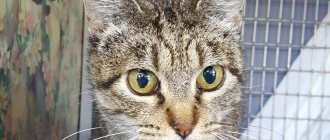10648Administration
1
Pregnancy is an important stage in the life of a pet. During this period, her behavior changes dramatically, and her body also undergoes many deformations. In order for the process to end with a successful birth, the owner needs to know how the cat’s pregnancy progresses week by week.
Pregnancy is an important stage in the life of a pet. During this period, her behavior changes dramatically, and her body also undergoes many deformations. In order for the process to end with a successful birth, the owner needs to know how the cat’s pregnancy progresses week by week.
Puberty of a cat
In most cases, the owner learns that the cat is ready for pregnancy when she is seven to nine months old. The exact timing of the first heat depends on many factors, such as heredity, living conditions, and individual characteristics. For example, in a large animal, sexual maturity will most likely occur no earlier than one and a half years. The breed does not matter, so a British cat can become pregnant at the same time as other felines.
Estrus manifests itself with characteristic signs. The cat begins to fuss for no reason or slowly walk around the house, caress more and meow pitifully.
At the same time, she willingly rubs against various objects, and in some cases even marks her territory. Despite the maturation of the pet, most experts advise mating no earlier than a year. Early pregnancy often results in difficult gestation followed by fatal delivery.
© shutterstock
When asked how long pregnancy lasts in cats, the answer is an average – nine weeks. But due to the influence of certain factors, the period may vary by a week, up or down. In case of significant deviations, we are talking about pathologies of gestation , which can only be eliminated in a veterinary office.
Signs of successful mating
The most successful period for mating is 3-5 days from the start of estrus. For the process to be successful, the cat must temporarily move in with the cat, and in the first few hours the animals may have misunderstandings and even fights. It is better to give the female time to calm down and get used to the new environment. It is best for the move to take place on the first day of estrus.
Moreover, the cat itself begins to flirt with the cat, provoking him to take active actions, then shows aggression, not letting him near her. Sometimes a cat covers a cat, several times, but the long-awaited success is not observed. In order to figure out whether full coverage has occurred or not, you need to know the signs of successful mating:
- After contact with the cat, the female begins to roll around on the floor.
- The mucous membranes of the genital organs swell and become brighter in color.
- The male completely loses interest in the cat, calmly moves away, and begins to lick himself with enthusiasm.
- If, nevertheless, the cat continues to pay attention to the female, he receives a sharp refusal.
- The cat may lose its appetite and become lethargic within 4 days.
If your cat has a fever and bleeding from the genitals, you should consult a veterinarian.
Mid pregnancy
Starting from the third week, the presence of kittens is diagnosed by a veterinarian during examination with palpation of the abdominal cavity. But already on the fourth or fifth, the growing fruits can be easily felt even with slight pressure. It is better not to perform such manipulations unless unnecessary, since careless movements can cause injury to the placenta and even miscarriage.
In the fifth week of pregnancy, the fetuses increase to six centimeters and exhibit characteristic feline characteristics.
But due to the fact that the uterus is filled with fluid, it is no longer possible to feel them. The cat's behavior changes again. She begins to absorb food in increased portions.
Birth of kittens
The most difficult thing for people without specialized education is determining the onset of labor in a pet.
There are several characteristic signs of a cat:
- anxiety;
- poor appetite or complete refusal to eat;
- licks and breathes frequently;
- settles in a certain place and does not leave it.
If the birth is too long and bleeding appears, then you cannot do without the help of specialists.
Late pregnancy
By the seventh week, pregnancy enters its final stage. During this period, the fruits are fully formed, full-fledged wool and other species characteristics appear. They move actively, sometimes becoming a cause of concern for the mother.
The approach of labor can be recognized by the following symptoms:
- the cat becomes unappetizing and inactive;
- her mammary glands enlarge even more, colostrum is released from them;
- Whitish discharge may appear from the uterus.
The nesting instinct also manifests itself, thanks to which the female walks around nooks and crannies, looking for a place to give birth.
© shutterstock
If, according to calculations, the last week of pregnancy has arrived, the cat becomes the most restless, and its temperature drops to 37 degrees, we can safely say that in three to four days it will be delivered.
At this time, it would be a good idea to conduct an ultrasound of the abdominal cavity to determine the number and size of kittens, as well as possible pathologies. This is especially important during the first birth.
Early signs
Not every mating can result in pregnancy. In the early stages, it is quite difficult to find out whether a cat has managed to get pregnant, but you can try to figure it out based on the following signs:
- If after mating the female continues into estrus, then most likely the long-awaited process has not occurred.
- After pregnancy, a cat can be affectionate.
- The animal develops drowsiness, apathy, and decreased appetite. The previously active mischievous woman has turned into a lazy creature - this is how hormonal changes affect her.
- A sharp change in the behavior of the female may indicate hormonal changes in the body.
- In the early stages, a change in the color of the nipples occurs, which turn pinkish. There are times when changes in color do not occur in all nipples, but only in some.
Recommendations for caring for a pregnant cat
When tracking the development of the fetus in a pregnant cat week by week, it is necessary to remember that she does not need special care. But for a more comfortable process, it is still necessary to adhere to some rules:
- To ensure that the cat is not exposed to temperature changes, is not injured and does not come into contact with sick animals, its pregnancy should, if possible, proceed at home.
- If there are other animals in the house, including cats, the pregnant woman must be removed before giving birth.
- To prevent cross mating, sexual contact between the pregnant woman and the cat should not be allowed.
- For safety reasons for mom and babies, it is better not to allow her to climb onto high objects from which she could fall.
- All regular veterinary procedures (vaccinations, deworming) must be postponed until the postpartum period, when the cat is strong enough.
- Do not use chemically active substances near the expectant mother.
- Monitor the condition of the pregnant woman and, if there is a sharp deterioration in health, seek the help of a veterinarian.
- To keep the cat clean in the last weeks of pregnancy, it is necessary to wash it with warm water, especially carefully lingering on the tummy and nipples.
How does this interesting situation unfold?
Caring owners expecting offspring keep special notebooks to monitor how their beloved cat’s pregnancy progresses. You can make a schedule week by week and note all the changes that occur with your cat. This will make it easier to compare the animal’s current health status with the norms. The table shows the optimal course of pregnancy.
Table - Cat pregnancy by week
| A week | Symptoms | Fruit size, cm |
| 3-4 | - Swelling, darkening of the mammary glands; - toxicosis, manifested by nausea, refusal to eat, morning vomiting; - decreased activity | 4 |
| 5-6 | — Increase in body weight; - rounding of the abdomen; - appearance of milk; - sharp increase in appetite | 6 |
| 7-8 | — Shedding; — active nesting; - decreased appetite; - movement of kittens | 9,5 |
| 9-10 | — Decreased activity, apathy; - noticeable enlargement of the mammary glands; - discharge of clear mucus from the vulva; - decrease in body temperature to 37°C | 12,5 |
Just before giving birth, the cat is active. The pet follows its owner, meows, and fusses in the area designated for lambing. The cat's figure becomes pear-shaped: the roundness moves towards the exit of the uterus. There are spasms - contractions. Having noticed these signs, the owner should prepare for childbirth.
Superfetation
During the third to sixth week of pregnancy, a cat may begin to undergo a planned estrus. This happens to one in ten pregnant cats and is considered normal in urban apartments. The body, which receives all the benefits for a happy life (light, warmth, food), “ignores” pregnancy and is ready to mate. This happens due to hormonal imbalance, namely due to a lack of progesterone, which is responsible for bearing offspring.
If your cat often licks her genitals or behaves restlessly, test for the presence of estrus. Apply a tissue to your vulva. If there are transparent spots left on it, the cat has flown.
There is no reason to worry, you just need to protect the expectant mother from potential sexual partners. Otherwise, re-fertilization will occur, which can result in one of three situations:
- miscarriage - both the “older” and “younger” offspring die;
- prematurity - the first kittens are born healthy, the second - premature or dead;
- repeat birth - three to six weeks after the first birth, the cat gives birth again (rarely happens).
The most favorable outcome for a cat is to give birth to healthy kittens from both fathers. However, the mother has a limited number of nipples, and the offspring from the second fertilization may die of starvation.
False pregnancy
It happens that symptoms of pregnancy appear, but the cat does not give birth. This is a false pregnancy. In fact, fertilization has not occurred, but the pet behaves like a future mother. Her shape becomes rounder, her mammary glands swell, and her appetite changes.
The cat begins to build a nest, becomes irritable or, conversely, quiet and calm. An imaginary pregnancy is clearly expressed in the “adoption” of slippers, socks, and mittens. The cat can carry things around the apartment like cubs, and even feed milk.
False pregnancy in cats is not a whim or a game of “mommy”, but a serious mental illness associated with hormonal imbalance. It appears in both mated and chaste pets. Siamese and Persian cats are prone to false pregnancies. Possible causes of hormonal imbalance are:
- stress, emotional shock;
- stimulating ovulation in a castrated cat;
- infectious diseases of the reproductive organs;
- pathologies of the thyroid gland;
- attention deficit;
- proximity to pregnant and lactating cats;
- heredity.
The disorder is treated with a low-calorie diet (milk production decreases) and medications prescribed by a veterinarian. Without treatment of false pregnancy, a cat may develop mastopathy. This is a disease of the pet's mammary glands, which leads to malignant tumors. Also, an imaginary pregnancy, left to chance, will have a bad effect on the psyche, character and behavior of the animal.
To protect your pet from mental and physiological disorders, it is necessary to carry out timely diagnosis of pregnancy. The easiest way to verify the presence of offspring is with an ultrasound, which can be done as early as the third week.











